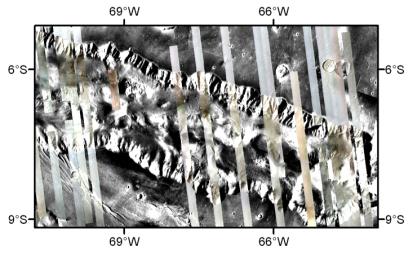This map of Eastern Candor Chasma, one of the deep valleys in Valles Marineris, was assembled from images taken by the Compact Reconnaissance Imaging Spectrometer for Mars (CRISM) over the first five months of orbital operations around Mars. Besides obtaining high spatial resolution targeted observations, CRISM is also compiling a global map at approximately 200 meters (660 feet) per pixel. That map is taken in 72 key wavelengths out of CRISM's total of 545, which are most sensitive to the presence of different minerals on the surface and gases in the atmosphere. The map is acquired as thousands of individual strips, each about 10 kilometers (6 miles) wide. Over the Mars Reconnaissance Orbiter's two-year primary science phase, these mapping strips will cover nearly the entire planet, in a manner similar to covering a beach ball with many thousands of pieces of string.
The part of the map shown here is composed of 20 observations overlain on a Mars Digital Image Model (MDIM). Valles Marineris originally formed as a huge fracture system caused by tectonic stresses related to the formation of the nearby Tharsis volcanic province. The troughs within Valles Marineris have been extensively modified since formation; water, wind and volcanic processes have been suggested to cause infilling by layered deposits that are kilometers in thickness. The steep walls of Candor Chasma bound a very complex canyon floor, with overlapping mesas, landslides, layered deposits and sand dunes.
This mosaic shows the brightness of the surface at three infrared wavelengths (2.52 micrometers in the red image plane, 1.56 micrometers in the green image plane and 1.08 micrometers in the blue image plane). Blue-green areas are rich in hydrated minerals, while dusty areas are bluish. Those observations with a reddish cast were taken during a time of increased dust in the atmosphere. Mosaics like this can be used to look at the regional distribution of interesting mineralogy and can guide further high-resolution imaging.
The Compact Reconnaissance Imaging Spectrometer for Mars (CRISM) is one of six science instruments on NASA's Mars Reconnaissance Orbiter. Led by The Johns Hopkins University Applied Physics Laboratory, the CRISM team includes expertise from universities, government agencies and small businesses in the United States and abroad.

 Planetary Data System
Planetary Data System












